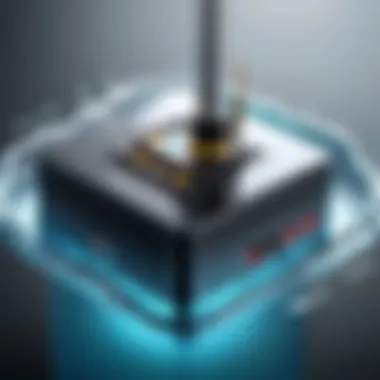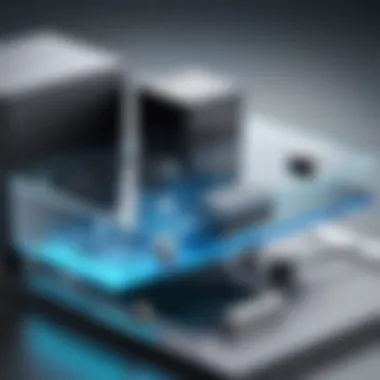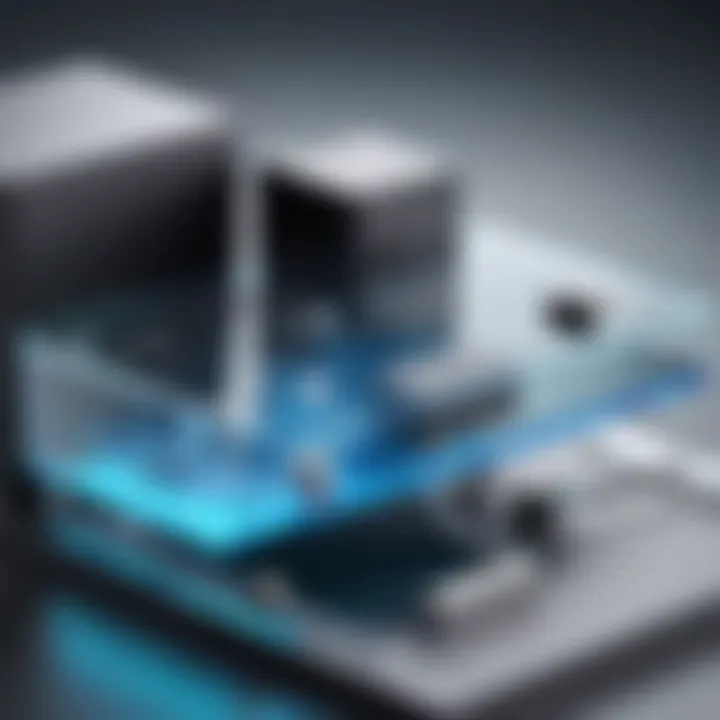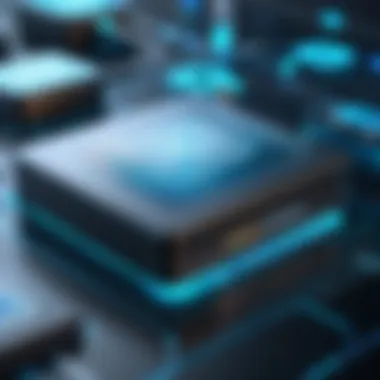Exploring Water Activated Switch Technology and Its Benefits


Overview of Topic
Water activated switch technology has emerged as an innovative solution that captures the essence of both efficiency and eco-friendliness. This tech revolves around switches that rely on the presence of water to operate, making it an increasingly practical choice for various applications in industries ranging from agriculture to consumer electronics. The significance of this technology stems from its ability to provide a sustainable, energy-efficient alternative to traditional switches that often depend on electrical or mechanical mechanisms.
Foreword to the Main Concept Covered
The heart of water activated switches lies in their simplicity and reliability. These devices detect moisture, prompting them to activate or deactivate a connected circuit. This mechanism is particularly useful in scenarios where manual operation is impractical or where automated responses are preferred. Simply put, when water touches the sensor, the switch reacts accordingly, either allowing current to flow or cutting it off completely.
Scope and Significance in the Tech Industry
The scope of this technology is vast and varied. In the agricultural sector, for example, water activated switches can help optimize irrigation systems, ensuring that water is allocated only when necessary. Likewise, in smart home applications, they can trigger systems for rainwater collection or management. This reduces waste and enhances conservation efforts, making these switches not just useful but vital in combatting the environmental challenges we face today.
Brief History and Evolution
The idea of harnessing water for operational purposes isn’t entirely new. Early versions of water activation can be traced back centuries when simple devices used water flow to trigger alarms or signals. However, the contemporary incarnation of these switches has evolved significantly, integrating modern materials and technologies to create robust solutions suited for today's fast-paced world. With recent advancements in sensor technology, these devices have become more sensitive and adaptable, opening the door to a wealth of new applications.
Fundamentals Explained
To truly appreciate water activated switches, it's important to get to grips with a few core principles.
Core Principles and Theories Related to the Topic
At the core of water activated switches is the principle of conductivity and capacitance. When water—an excellent conductor—comes into contact with specific materials, it alters the electric path, enabling or disabling a signal. This action can be influenced by various factors, including temperature and pressure, making it essential to understand these variables when designing the system.
Key Terminology and Definitions
- Sensor: A component that detects the presence of water.
- Activation threshold: The level of moisture required to trigger the switch.
- Circuit: The pathway through which electric current flows.
- Moisture-sensitive material: Substances designed to respond to water presence.
Basic Concepts and Foundational Knowledge
Understanding the basic components of a water activated switch is key. Typically, they consist of a sensor, a relay, and the controlling circuit. When the sensor detects moisture, it sends a signal to the relay, which subsequently opens or closes the circuit. This interaction is not only straightforward but also allows for easy integration into various systems without needing complex setups.
Practical Applications and Examples
The real-world applications of water activated switch technology are as diverse as they are impactful.
Real-world Case Studies and Applications
- Agricultural Irrigation Management: Farmers can automate their irrigation systems using these switches, which detect soil moisture levels and only activate watering when necessary. This leads to significant water conservation.
- Smart Home Systems: These switches can be integrated into home automation systems to manage things like garden irrigation or even flood detection, enhancing safety and efficiency.
- Industrial Machinery: In factories where equipment may be exposed to water, these switches can act as protective measures, ensuring that machinery only operates under safe moisture conditions.
Demonstrations and Hands-on Projects
Hands-on projects with water activated switches can range from simple prototypes to complex systems. For example, creating a moisture detection system for a potted plant can provide a valuable learning experience. The setup typically consists of the sensor, a microcontroller for processing the input, and an alert system to indicate when watering is needed.
Code Snippets and Implementation Guidelines
While specific implementations will vary widely, here’s a bare-bones example of a simple code block for Arduino based systems:
Advanced Topics and Latest Trends
Cutting-edge Developments in the Field
Recent times have seen remarkable improvements in the sensitivity and stability of water activated switches. New materials are being introduced that offer better resilience to adverse weather conditions, making them suitable for outdoor environments.
Advanced Techniques and Methodologies
Incorporating machine learning into the functioning of water activated switches may hold the future for more sophisticated automation. By analyzing patterns of water presence and usage, systems can learn and adapt, optimizing their operations further.
Future Prospects and Upcoming Trends
As the global focus pivots toward sustainability, the demand for water efficient solutions is likely to spike. Expect to see more integration of these switches into IoT systems, where they can communicate with other devices to create smarter living spaces.
Tips and Resources for Further Learning
For readers interested in diving deeper into water activated switch technology, a few key resources can help:
- Books: Look for publications focused on sensor technology and automation systems.
- Courses: Online platforms like Coursera or Udemy may have relevant classes covering electronics and programming fundamentals.
- Tools and Software: Circuit simulation software like Fritzing can assist in designing circuits before actual implementation.
In summary, the journey into understanding water activated switch technology is both fascinating and essential for those interested in electronics and sustainable practices.
Prolusion to Water Activated Switches
Water activated switches embody an innovative approach to automation and control, utilizing the simple but effective principle of water to trigger a response. This topic gains traction as the world seeks efficiency in technology while being mindful of environmental wellness. The essence of these devices lies in their ability to blend functionality with eco-friendliness, paving the way for applications in various fields such as home automation and industrial settings. This article dives deeper into these switches, unraveling their benefits, applications, and future directions in the realm of technology.
Definition and Basic Functionality
At its core, a water activated switch is a device that operates upon exposure to water, typically engaging in a specific action like turning on a light or triggering a system. It consists of a sensor or detector that responds to moisture and activates the compatible system connected to it. When water comes into contact with the sensor, it completes a circuit or signals a control unit that initiates the action at hand.
The basic functionality can be summarized as follows:


- Activation: Water contact is the primal trigger.
- Response: Once activated, the switch can serve multiple purposes—from lighting irrigation systems in agriculture to controlling pumps in aquatic environments.
- Integration: These switches can be integrated into automated systems, providing a level of convenience that traditional switches may lack.
p>The beauty of this technology lies in its ability to harness natural elements for practical purposes, helping to reduce reliance on manual controls.p>
Historical Context and Development
The concept of using water in switch technology is not entirely new; it has roots that can be traced back to early hydraulic systems. Ancient civilizations used water flow to perform mechanical tasks, but modern water activated switches evolved significantly over time.
In the late 20th century, advancements in sensor technology and materials science allowed for more practical and efficient designs. Water activated switches gained popularity in various industries, leading to designs that offer precision, reliability, and cost-effectiveness. Early adopters recognized the potential for automating irrigation systems, which was a significant breakthrough in agriculture.
"Innovations in water activated switches not only streamline operations but also play a pivotal role in sustainable technology."
By the 21st century, these switches had found applications beyond even agriculture, spreading into smart homes and environmental monitoring. The ongoing quest for energy-efficient and environmentally conscious solutions has further propelled the development of this technology, encouraging more industries to explore its capabilities.
Overall, the historical context underscores a shift towards integrating environmentally sustainable solutions in everyday technology, making water activated switches relevant not just as a novelty but as a practical and responsible choice.
Principles of Operation
Understanding the principles of operation for water activated switches is essential for anyone looking to grasp the intricate workings of this technology. These principles not only highlight how water activation occurs but also shed light on the benefits and considerations regarding implementation. Water activated switches operate fundamentally on the interface between water and electronic controls, translating the presence of water into a functional command, which is pivotal across multiple industries.
Mechanism of Activation
At the heart of water activated switches lies their mechanism of activation, which essentially determines when and how the switch responds to water presence. When water comes into contact with the sensing component of the switch, it leads to a change in electrical conductivity. This conductivity shift triggers a signal that prompts the activation of the switch.
For instance, imagine a system in a smart irrigation setup. The water contact with the switch overrides standard operational parameters when certain moisture levels are detected, enabling irrigation systems only when necessary. This not only conserves water but also enhances efficiency. The sensitivity of the switches can be adjusted, thus permitting varied applications—from home gardens to large agricultural fields.
Sensor Technology
Diving deeper, the role of sensor technology in these switches can’t be overstated. Sensors used in water activated switches must be designed to withstand potential corrosion from water and debris, ensuring longevity and reliability. The technology has evolved significantly, with options like capacitive and resistive sensors gaining traction.
Using capacitive sensors, for example, allows the system to detect even slight variations in moisture levels. Conversely, resistive sensors work by measuring the current flowing through the water, making them more sensitive to water conductivity. Each type has its advantages and specific best-use scenarios. Choosing the right sensor technology is crucial, especially when considering environmental conditions and longevity of the devices in use.
Switching Mechanism
The switching mechanism in these devices is another critical element that demands attention. Essentially, once the sensor detects water, it initiates a relay or direct switch action that can close or open a circuit. The simplicity or complexity of this switching mechanism can vary widely based on the application.
For example, some switches instantly cut power to electrical appliances when water is detected, providing immediate safety to users. Others might employ a more delayed action, allowing for notifications to be sent before power shut-off, a feature often integrated in home automation systems.
"The effectiveness of water activated switches hinges on the precision and reliability of both sensor technology and switching mechanisms used."
Conclusively, the operation of water activated switches is a multifaceted subject that combines elements of sensor technology, the mechanics of activation, and the outcomes of switching mechanisms. Understanding these principles is not merely an academic exercise but a foundational aspect for developers, IT professionals, and environmentalists aiming to leverage such technology in sustainable practices.
Components of Water Activated Switches
When discussing water activated switches, one cannot overlook the critical components that make these systems function effectively. Understanding these elements not only sheds light on how the technology works but also highlights their benefits and considerations in various applications. Each part plays a pivotal role in ensuring the switch responds accurately and dependably in water-rich environments.
Sensors and Detectors
The heart of a water activated switch lies in its sensors and detectors. These components are designed to detect the presence of water and activate the switch accordingly. There are a few different types of sensors used, ranging from simple mechanical switches to more advanced capacitive sensors.
- Mechanical Sensors: Often, these are basic float switches that operate on the principle of buoyancy. When water rises to a certain level, it displaces the float, triggering the switch.
- Capacitive Sensors: On the fancier end, capacitive sensors detect changes in capacitance caused by the presence of water. They can be very sensitive and are often used in applications where precision is crucial.
The responsiveness and accuracy of these sensors are vital for the overall effectiveness of the water activated switches. If they fail to react under specific conditions, it can lead to malfunctions or safety hazards. Thus, selecting high-quality sensors is essential for reliable operation.
Control Circuits
Control circuits are the brains behind water activated switches. They connect the sensors to the switching mechanism and manage how the system operates once water is detected. Control circuits can be quite simple or involve more complex microcontroller systems that enable programmable features.
- Basic Control Circuits: In simpler designs, control circuits may consist of a relay that engages when the sensor signals water presence.
- Advanced Microcontrollers: On a more sophisticated level, these circuits can allow for specific programming. For example, a system may be designed to run a pump when water is detected but only after a certain time delay.
The importance of these circuits cannot be overstated. They not only enhance the functionality of water activated switches but also add layers of safety and user control.
Power Sources
Power sources for water activated switches can greatly influence their design and deployment. Typically, these systems require an electrical supply to operate effectively, but the way power is supplied can vary.
Here are some commonly used power options:
- Direct Electrical Connection: This is often the most straightforward method, providing a steady flow of electricity from a wall outlet or a dedicated power supply.
- Battery-Powered Systems: In situations where electrical access is limited or non-existent, battery power provides flexibility. However, the trade-off here is the need for regular maintenance to replace or recharge batteries.
- Solar-Powered Solutions: Some modern designs incorporate solar panels, making them a sustainable choice for outdoor settings. They depend on sunlight, thus might not be reliable under consistently cloudy conditions.
Applications in Various Industries
Water activated switches have carved a niche for themselves across several industries, making significant impacts in functionality and sustainability. These switches, which are responsive to the presence of water, offer unique advantages that traditional switches simply can’t match. The relevance of this technology spans home automation, industrial scenarios, and even agricultural practices, and it's vital to understand the specific roles these switches play in each of these areas.
Home Automation
In the realm of home automation, water activated switches provide a seamless and intuitive interface. Smart homes are increasingly incorporating sensor-driven designs, allowing occupants to control various devices with mere presence or movement of water. For example, a homeowner may install a water activated switch in the bathroom to turn on the lighting when someone steps into the shower. This not only enhances convenience—no more fumbling for light switches with wet hands—but it also integrates nicely with existing smart home systems.
Moreover, safety is paramount in households, and using water as a means of activation increases this factor significantly. It minimizes the risks associated with electrical hazards in wet environments. Additionally, these switches can be programed to monitor water usage and send alerts if leaks or unusual patterns are detected, making them versatile tools for home maintenance.
Industrial Use Cases


The industrial applications of water activated switches are far-reaching and quite multifaceted. One prominent area is within manufacturing facilities, particularly those dealing with hazardous materials. These facilities often rely on precise control means, and water activated switches can provide rugged and reliable activation points that withstand harsh conditions.
For instance, a factory might utilize a water activated switch in its cooling systems. When a temperature threshold is crossed, and water levels are detected, these switches can automatically activate fans or pumps, ensuring operational efficiency. Additionally, in settings where fluid management is crucial, such as in chemical processing plants, these switches can act as a fail-safe mechanism. They’re programmed to shutdown equipment if unexpected water contact occurs, which helps contain potential spills and protect both workers and the environment.
Another example in industrial settings is their role in wastewater management. Water activated switches can help automate valves or gates, allowing for efficient navigation of water flow for treatment. This application is not only practical but showcases the technology’s potential to streamline processes across various sectors, ultimately leading to operational cost savings.
Agricultural Innovation
The agricultural sector is another field where water activated switches shine brightly. With the significant challenges posed by climate change, farmers are on the hunt for innovative tools to aid in water conservation and efficient irrigation practices. Water activated switches can directly address these concerns by providing automatic control over irrigation systems.
For example, a farmer might use a network of these switches connected to moisture sensors in the field. When soil moisture levels drop below a certain point, a water activated switch can trigger irrigation to begin. This direct response not only conserves water but also ensures crops receive optimal amounts, promoting healthy growth.
Additionally, these switches can enhance the monitoring of farming equipment. In scenarios where irrigation systems utilize pumps, water activated switches can act as safety shutoff mechanisms to prevent overheating by disconnecting power if water flow is impeded. This practical application ties directly into sustainability, showcasing the potential for innovative strategies in farming.
"Water activated switches symbolize a leap toward modernizing everyday controls, integrating seamlessly with our environmental and operational needs."
In summary, the applications of water activated switches across industries such as home automation, industrial operations, and agricultural innovation are both diverse and impactful. They demonstrate a blend of practicality, efficiency, and a conscious nod towards sustainability, establishing their importance in today’s technological landscape.
Advantages Over Traditional Switches
Water activated switches present a myriad of advantages compared to conventional electric switches. Their functionality is not just a novelty; it's a sign of shifting paradigms in technology that prioritize efficiency, sustainability, and safety in our ever-evolving world. Understanding these benefits aids professionals and students alike in grasping why this technology is worth investing time and resources into.
Environmental Benefits
One of the standout features of water activated switches is their environmental responsibility. They operate on the principle of triggering a mechanism using water, which means they can often replace energy-consuming electrical systems in various applications. This helps in reducing the overall carbon footprint.
For instance, consider a garden irrigation system that incorporates these switches. Instead of a traditional system that relies on electrical timers, water activated switches can turn irrigators on and off based on moisture levels, leading to less water wastage and reduced energy consumption. This is a prime example that illustrates how switching to water-activated technology can benefit the planet by conserving natural resources and minimizing energy use.
"Adopting innovative solutions like water activated switches reflects a commitment to a more sustainable future, where technology harmonizes with nature."
Furthermore, many water activated switches are designed with sustainable materials, enhancing their green credentials. The potential for biodegradable components means that even at the end of their life cycle, these switches are less likely to contribute to the growing electronic waste problem.
Energy Efficiency
Energy efficiency is another critical area where water activated switches have an edge over traditional switches. By utilizing water as a medium to activate, these switches eliminate the need for constant electrical power. The reliance on water means that they can be operational without drawing unnecessary energy, leading to a significant reduction in energy costs over time.
An example might be found in smart homes, where water activated switches can work seamlessly with existing plumbing systems, cleverly reducing energy requirements. They can switch on lights or appliances only when needed, thanks to their design that allows them to respond directly to water flow or presence. Such energy-saving capabilities indicate that integrating water-activated technology not only conserves energy but also results in significant cost savings for consumers and businesses alike.
Safety Features
Safety is paramount in any switch technology, and water activated switches rise to meet this need in a unique way. Their operation utilizes non-electrical mechanisms, which inherently reduces the risks associated with conventional electric wiring—like electrical shocks or short circuits.
These switches, often employed in settings where water is prevalent—like bathrooms or outdoor areas—have an added advantage; the absence of exposed electrical components significantly enhances user safety. Imagine a lights control in a wet area: by using a water activated switch, the risk of a potentially dangerous situation drops drastically.
Additionally, these switches can be designed to include fail-safes that activate or deactivate depending on water presence, furthering redundancy. This not only protects users but also underscores the safety commitment that modern technology should strive for.
In summary, water activated switches are not merely an alternative to traditional systems but represent a holistic approach to energy efficiency, environmental responsibility, and user safety. As industries and everyday consumers begin to adopt these technologies, the implications for both the economy and the environment become significantly positive.
Design Considerations
When it comes to water activated switch technology, design considerations play a pivotal role in ensuring both functionality and reliability. These switches are often employed in various environments where exposure to moisture is inevitable, which makes choosing the right materials and design features very crucial. Below, we delve into key elements of design considerations that are essential for developers and engineers working in this field.
Durability and Material Selection
Durability is an absolute must for water activated switches. The materials used must withstand not just water exposure but potential contaminants as well. For instance, a switch in a kitchen sink might get splashed with greasy water, whereas one installed in an agricultural setting might face direct contact with soil and muck.
Common materials include:
- High-grade plastics: They provide a level of resistance to moisture and corrosion.
- Stainless steel: Known for its ruggedness and anti-corrosive properties, it is often a choice for outdoor applications.
- Silicone seals: These can enhance the waterproof joints, providing extra defense against water ingress.
Moreover, the material selection should consider the weight and ergonomics of user interaction. A switch that feels sturdy but is too heavy to handle could be a deterrent in user acceptance.
Water Resistance Standards
Standards for water resistance are not mere formalities; they dictate how well the switch performs in adverse conditions. Most professionals turn to IP ratings, where a higher rating symbolizes better protection against water and dust.
- IP67: This rating assures that the device is protected against immersion in water up to a depth of one meter for a short duration.
- IP68: A notch above, allowing for continuous immersion under certain conditions.
A water activated switch needs to meet these standards to ensure longevity and reliable operation. Understanding these classifications enables engineers to design better devices that can endure real-world conditions, thus maintaining their functionality and ensuring user safety.
"Devices designed without considering water resistance can lead to catastrophic failures, rendering the technology ineffective against its intended purpose."
User Interface and Experience
The user interface is the frontline in how users engage with water activated switches. A seamless user experience hinges on how intuitive the switch is, especially for someone who might be encountering the technology for the first time.
Considerations for effective UI design include:
- Simplicity: Too much complexity can easily confuse users. The mechanics should be such that any user can activate it without a manual.
- Feedback Mechanism: Visual or auditory feedback indicating that the switch is activated can greatly enhance usability. Employing simple LED indicators can be a straightforward solution.
- Accessibility: The design must cater to people of all abilities. This might mean designing a larger button or ensuring the switch is positioned within easy reach.
In summary, the design of water activated switches involves a multi-faceted approach where each element from materials used to user interaction is essential. By paying attention to durability, water resistance standards, and user experience, developers can create reliable and effective technology that meets the needs of diverse applications.


Challenges and Limitations
Water activated switches, despite their innovative technology and numerous advantages, are not without challenges. Understanding these limitations is crucial for users, manufacturers, and researchers alike. This section lays out the pitfalls that engineers must navigate when designing and implementing these systems. It’s a complex balancing act, ensuring functionality while mitigating risks.
Reliability in Extreme Conditions
One major challenge stems from the varying environments in which these switches must operate. Water activated switches face reliability concerns in extreme conditions—be it freezing temperatures, high humidity, or excessive pressure. For instance, during winter months, ice could potentially interfere with the sensor activation. In very humid climates, unexpected moisture could lead to erroneous triggers. Ensuring that switches can withstand such conditions without compromising functionality is crucial.
"Adaptability is key when it comes to environmental variations."
Manufacturers generally seek to design components that maintain operational integrity in adverse conditions, but this often leads to increased complexity in the design phase. Engineers have to employ materials that resist water ingress but remain responsive enough to ensure accurate activation.
Cost Implications
Cost is another significant hurdle. Developing and producing high-quality water activated switches can become quite pricey. The reliability and durability features that are often required may add to the price tag of production. This means that, while the end user may save on energy and maintenance costs, the initial investment might be a stretch for smaller businesses or residential implementations.
- Factors influencing cost:
- Material quality: Higher quality materials often come at a premium.
- Integrated technology: Advanced features like remote control or feedback mechanisms can raise expenses.
- Manufacturing complexity: More complex designs usually mean higher labor and production costs.
Ultimately, users must weigh these initial costs against long-term savings—a calculation that may not favor adoption for all potential customers.
Technical Expertise Required
Finally, there’s the issue of technical expertise required for effective installation and maintenance of these systems. Unlike traditional switches that a homeowner might swap out with minimal know-how, water activated switches often necessitate a deeper understanding of their operating systems. For example, setting up sensors that accurately gauge water levels and ensure proper activation without false positives can be quite intricate.
- Necessary skills include:
- Electrical knowledge: Understanding circuits and electrical flow is essential.
- Troubleshooting skills: Preventing operational failures requires a knack for identifying problems swiftly.
- Familiarity with technology: As integration with other smart home systems increases, knowledge of networking and software becomes necessary.
While training programs exist, the dependency on a skilled workforce can become a barrier for some interested in deploying this technology. The goal remains to simplify these systems without sacrificing functionality, but this requires ongoing development within the field.
In summary, acknowledging the challenges of reliability in extreme conditions, cost implications, and necessary expertise is key for anyone looking to delve into the world of water activated switch technology. Each point requires careful consideration and strategic planning, ensuring users can benefit from the technology without falling prey to its pitfalls.
Future Developments in Water Activated Switch Technology
The landscape of water activated switches continues to evolve as several cutting-edge advancements promise to enhance their functionality and applicability. As this technology grows, its integration into various systems becomes increasingly relevant—not just for improving efficiency but also for creating a more sustainable framework across industries.
Integration with Smart Technologies
In today’s fast-paced tech environment, marrying water activated switches with smart home technology represents a significant leap forward. Imagine a scenario where your irrigation systems automatically respond to soil moisture levels, triggered by water-activated sensors. These switches can facilitate seamless communication with smart devices, making it simpler for users to manage resources effectively.
- Enabling home automation through platforms like Google Home or Amazon Alexa.
- Customizable triggers that can activate cleaning systems, irrigation, or even security alerts based on water detection.
As this technology integrates further, the connectivity could lead to systems that not only conserve water but also optimize energy usage across homes, planting the seeds for future energy-efficient solutions. It is important to note that the integration must also take reliability and user-friendly interfaces into account to ensure widespread adoption.
Advances in Sensor Technology
The evolution of sensor technology plays a pivotal role in enhancing the reliability and responsiveness of water activated switches. Recent developments pave the way for more sensitive and adaptive sensors that can distinguish between various water types, which is crucial for applications in diverse environments.
Next-generation sensors might incorporate:
- Smart calibration that can auto-adjust based on environmental conditions.
- AI algorithms to improve decision-making, thus enhancing the overall effectiveness of water activation mechanisms.
This shift won’t just improve operational efficiency; it can lead to more innovative solutions in leak detection systems or flood prevention strategies, becoming indispensable tools in sectors heavily reliant on robust water management practices.
Potential for Customization and Scalability
One of the most exciting prospects in the domain of water activated switches is the potential for customization and scalability. As industries begin to realize the unique needs of their operational environments, a one-size-fits-all approach may no longer suffice.
Customization may include:
- Tailored functionalities based on specific operational challenges.
- Brands providing adaptable switch designs that can easily merge with existing systems or grow with business needs.
- Modular designs that allow users to scale their capabilities without starting from scratch.
- For instance, agriculture could deploy switches that respond uniquely to different crop types.
This focus on tailored solutions opens pathways for niche applications, stimulating market innovation. Moreover, the ability to scale can assure stakeholders that investing in this technology can yield long-term benefits without making the initial installation burdensome.
As we look ahead, the convergence of these developmental trends paints a promising picture for water activated switches. This technology's potential not only reflects its capabilities to reduce wastage and enhance efficiency but also showcases its ability to meet the unique demands of a changing world.
End
In wrapping up our exploration of water activated switch technology, it's crucial to recognize the transformative potential this innovation holds across various spheres. With environmental sustainability and energy efficiency at the forefront of contemporary technological discussions, water activated switches present a valid solution by merging functionality with eco-conscious design. Their ability to operate without traditional electrical sources underscores a pivotal shift toward solutions that respect and utilize natural resources.
Recap of Key Insights
Reflecting on the journey through this article, we’ve uncovered several key insights regarding water activated switches:
- Functionality: These devices seamlessly integrate into home automation, industrial systems, and agricultural setups, adapting to diverse operational needs.
- Environmental Impact: By lessening reliance on conventional electricity, they emit lower carbon footprints, aligning with global sustainability goals.
- Innovative Design: Advances in sensor technology and user interfaces illustrate the shift toward smarter, more adaptable solutions in our tech landscape.
The combination of these elements creates a strong case for adopting such technologies in both existing and future infrastructure.
Implications for Future Research
As we peer into the future, the horizon of water activated switch technology opens up a myriad of paths for research and development. This field is ripe for exploratory studies that can amplify its existing benefits:
- Integration with Smart Technologies: Future systems can harness the capabilities of the Internet of Things (IoT), creating devices that not only react to water but also communicate with other smart systems for improved automation.
- Advancements in Sensor Technology: There's space for refinement in sensor accuracy and responsiveness, which could elevate the reliability of these switches in challenging environmental conditions.
- Customization and Scalability: Understanding the diverse requirements of various industries can lead to a more tailored approach in designing water activated switches that meet specific demands.
Given the implications of water activated technology, continued investment into research could well facilitate the evolution pathways of energy management, environmental preservation, and user experience in electrical devices.







